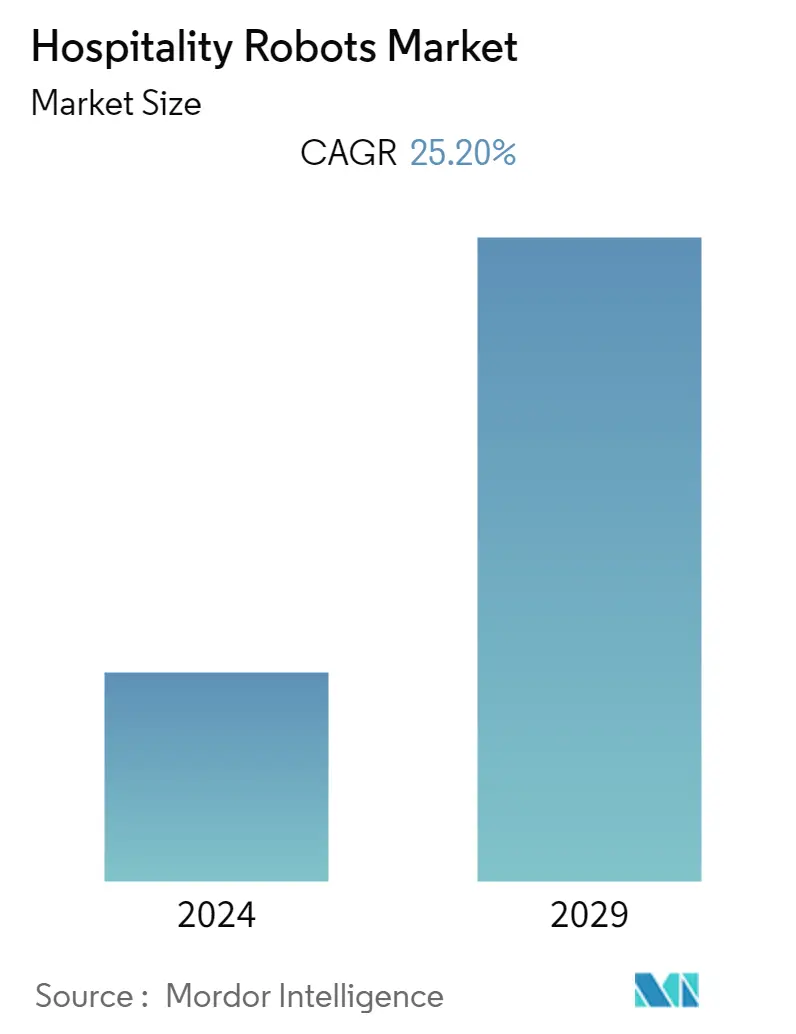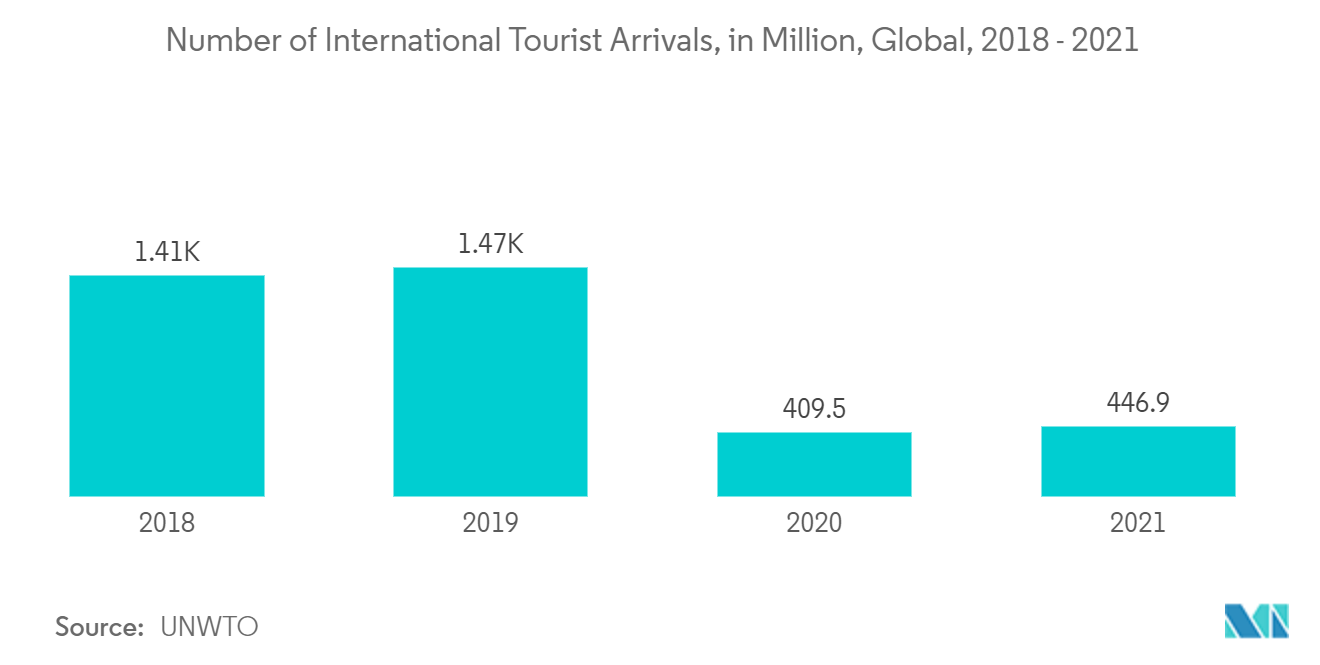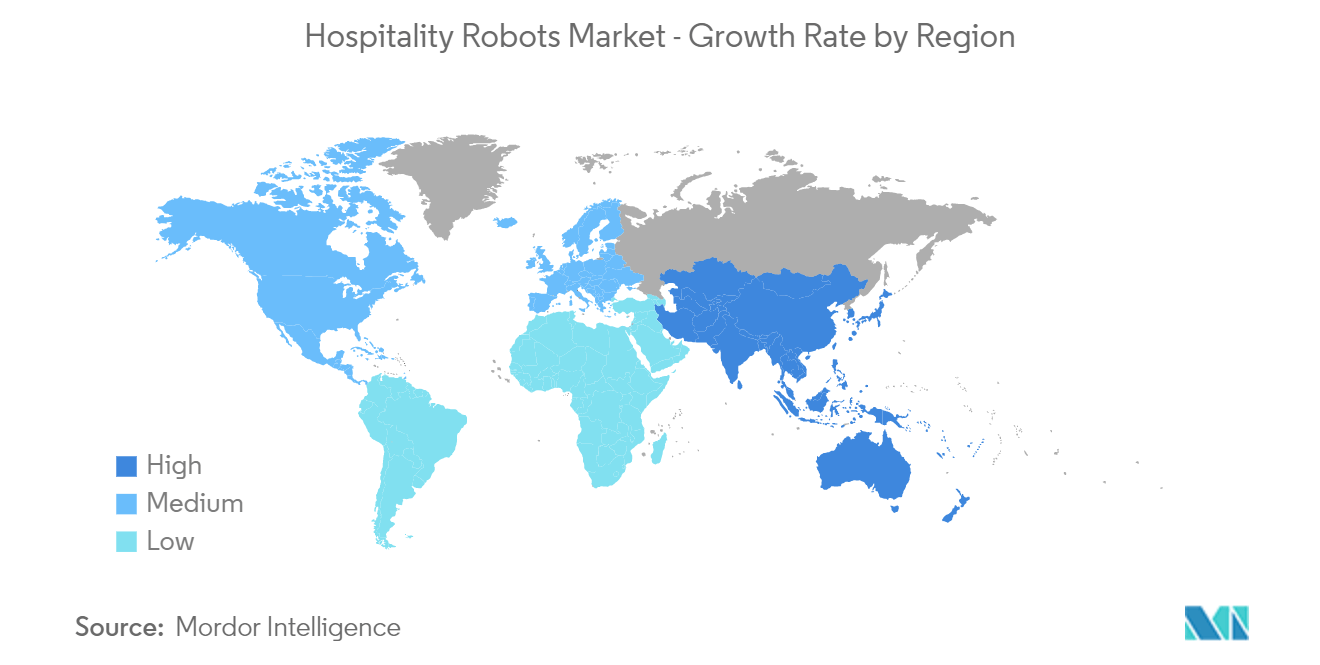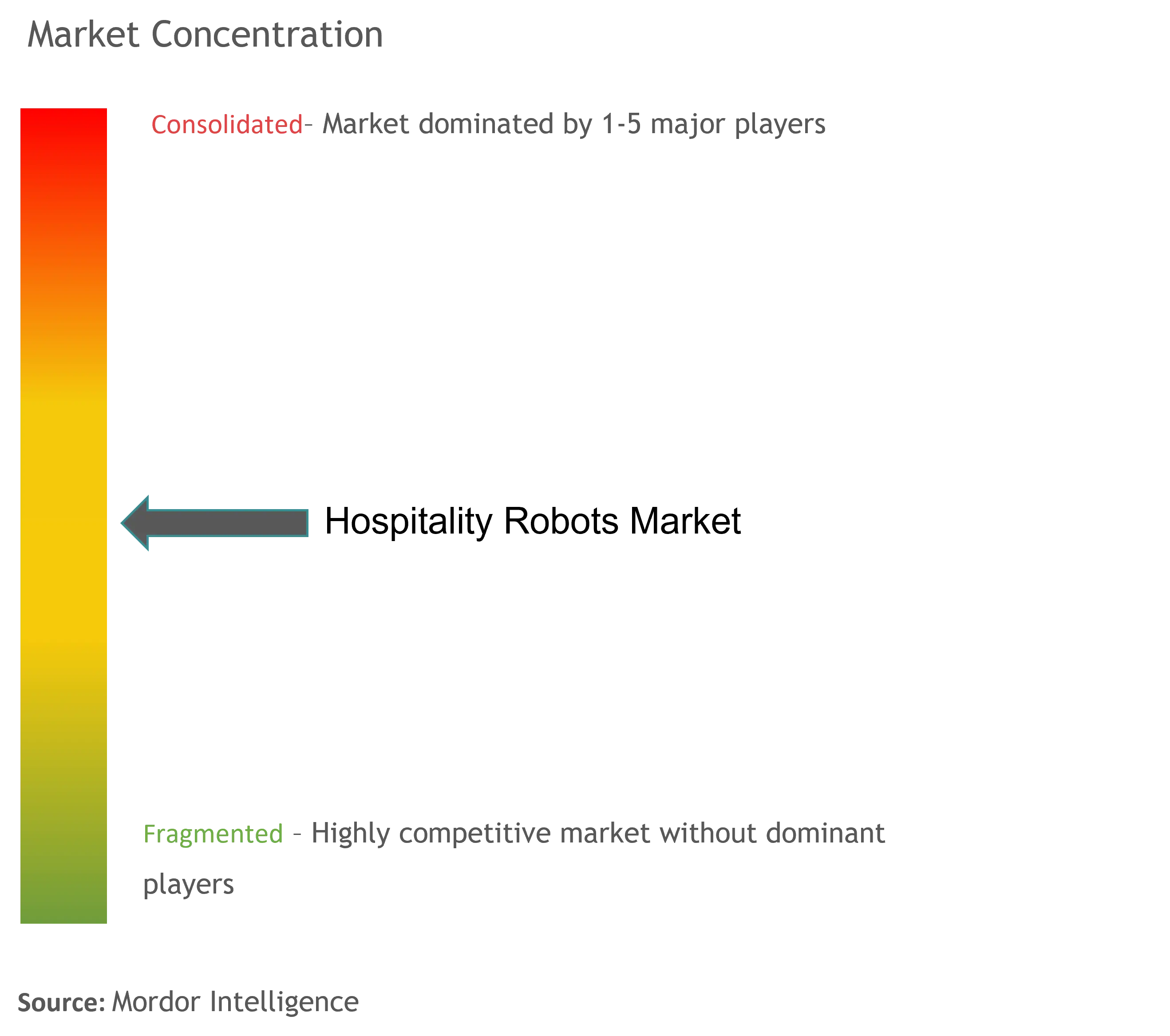Hospitality Robots Market Size

| Study Period | 2019 - 2029 |
| Base Year For Estimation | 2023 |
| CAGR | 25.20 % |
| Fastest Growing Market | Asia-Pacific |
| Largest Market | North America |
| Market Concentration | Medium |
Major Players.webp)
*Disclaimer: Major Players sorted in no particular order |
Hospitality Robots Market Analysis
The Hospitality Robots Market is expected to grow by registering a CAGR of about 25.2% during the forecast period. The uses of robotics have expanded significantly within the hospitality industry, ranging from artificially intelligent chatbots designed to assist with the customer service process to robot assistants deployed to improve guests' experience in a hotel. The increasing proliferation of digital and automation technologies among hospitality service providers to enhance customer satisfaction and operational efficiency are among the key factors driving the market's growth.
- Over the years, advancement in digital and automation technologies such as AI, ML, IoT, etc., has significantly contributed to the development of robotics technology, making them more versatile, compact, multifunctional, and affordable. With a growing range of use cases primarily for improving customer experience, brand awareness, and customer loyalty, the use of robots within the hospitality industry is becoming more commonplace.
- Some common examples of robots currently being used in the hospitality industry include mobile guidance robots, cleaning robots, and food preparation and housekeeping robots, among others. Robots are also increasingly used for various other purposes, such as luggage handling, security, sanitization, etc. For instance, Travelmate is a robotic suitcase by Travelmate Robotics that can follow its owner.
- Furthermore, the use cases of mobile technology to order food and beverages have expanded significantly, as robots nowadays are even capable of accepting the customer's order, preparing meals and drinks, and serving them. Thus, growing technological advancement and increasing utility of robots in hotels, restaurants, and other facilities drive innovations and demand for hospitalization robots, encouraging vendors to develop innovative solutions.
- For instance, in June 2022, Super Eagle Technology, a recognized name in the food machinery industry, launched its AI robot server, IPAW Model L, for the hospitality industry. The robot boasts advanced features such as accurate navigation, voice interaction, intelligent obstacle avoidance, a collaboration of multiple machines, etc.
- However, the higher installation and operating costs associated with these robots are among the primary factors challenging the studied market growth. Furthermore, lower awareness and lack of skilled workforce, especially in less developed regions, are among the factors challenging the market's growth.
- The outbreak of COVID-19 has had a notable impact on the growth of the studied market. While the demand witnessed a significant drop, especially during the initial phase of the pandemic owing to various restrictions imposed, the order has been witnessing a gradual growth since then as these robots minimize interpersonal communication helping to contain the spread of the virus.
Hospitality Robots Market Trends
This section covers the major market trends shaping the Hospitality Robots Market according to our research experts:
Growth of the Tourism Industry and Number of Tourists to Drive the Market
- Tourism is defined as the movement of people from one place to another for several purposes (business, recreational, pleasure, etc.). As the hospitality industry includes enterprises that provide accommodation, food, and lodging services in venues outside of the home, the tourism industry directly impacts its growth.
- Before the coronavirus outbreak, the global tourism industry had witnessed almost uninterrupted growth for decades. Although the pandemic has impacted the sector's growth in the last couple of years, the industry has started showing signs of recovery. For instance, according to UNWTO, compared to the year before, international tourism increased by 182% in the first three months of 2022.
- A similar trend has been observed across various countries and regions as well. For instance, according to the Office of National Statistics, United Kingdom (UK), foreign visitors had about 3 million visits to the UK in June 2022, compared to 2.8 million visits in May 2022. Similarly, according to Statistics Canada, in the second quarter of 2022, tourism spending in Canada increased by about 19.8%
- Such trends are expected to positively impact the hospitality industry as the increase in tourists, and general travelers will drive revenue. Although the adoption of robotics was growing steadily during the pandemic, it is expected to grow faster post-COVID, considering a higher consumer awareness about maintaining hygiene and interpersonal communication. Additionally, the changing approach of the hospitality service providers, wherein the focus has been shifting to providing more personalized and innovative customer experience, is also expected to create a favorable market scenario for the growth of the studied market.

Asia Pacific to Become a Major Demand Driver
- The Asia Pacific region is witnessing remarkable economic growth in the last few decades primarily due to the rise of the industrial sector. Countries like China, Japan, South Korea, etc. are among the fasted growing countries of the region wherein the infrastructural development, growing acceptance of digital technologies, and the willingness of hospitality service providers to offer a highly personalized and pleasant customer experience are driving the demand for hospitality robots.
- Raising productivity and easing a manpower crunch were also among the original triggers behind the deployment of hospitality robots and contactless technology in Asia's hospitality sector, especially in the countries such as Japan which the outbreak of the pandemic has further supported.
- Henn-na Hotel, located in Nagasaki, Japan, is among the first few hotels in the country with a robotic working staff. The hotel has multilingual robots to help the guests check in to the hotel. It also has porter robots to carry luggage up to the guest rooms. Furthermore, the hotel also has humanoid robots to provide a human touch and make interactions easy.
- Additionally, several cases have been identified wherein business owners are adopting robotic technologies to deal with the worker shortage. For instance, during the Beijing 2022 Olympic Winter Games, several restaurant owners turned to cater robots that can serve tableware and dishes and communicate with customers.
- Similarly, to combat staff shortage, a Thai restaurant in Melbourne, Australia, employed a new waiter called Bella, that is programmed to know the layout of the tables and deliver food from the kitchen. Considering the convenience and attraction these robots bring, especially from younger customers, the demand for these robots is expected to grow further during the forecast period.

Hospitality Robots Industry Overview
The hospitality robots market is growing in competition as consumer awareness and acceptance drive the demand for these robots. The increasing demand, in turn, is grabbing new vendors' attention in the market, which is expected to drive competitive rivalry among the vendors. New product innovations, partnerships, and acquisitions are among the key strategies adopted by the vendors to strengthen their market presence further. Some major market vendors include Relay Robotics Inc., LG Electronics Co. Ltd., Bear Robotics Inc., Hyundai Robotics Co., Ltd., etc.
- June 2022 - Relay Robotics, Inc., a supplier of service robots to the hospitality, healthcare, and real estate industries, announced that it would be exhibiting its Relay+ Service Robot, a robot designed for hospitality services, at the 2022 Hospitality Industry Technology Exposition and Conference (HITEC), at the Orange County Convention Center in Orlando, Florida.
- May 2022 - Relay Robotics, a new venture formed by Relay's acquisition of robotics developer Savioke, raised USD 10 million in a series A financing round led by MK Capital. The company would be using the funding to accelerate the development and deployment of its delivery robots.
Hospitality Robots Market Leaders
-
Relay Robotics Inc.
-
LG Electronics Co. Ltd
-
Bear Robotics, Inc.
-
Hyundai Robotics Co., Ltd.
-
Connected Robotics Inc.
*Disclaimer: Major Players sorted in no particular order

Hospitality Robots Market News
- March 2022 - Bear Robotics, a robotics company offering hospitality robots, raised USD 81 million, bringing the company's total funding to USD 117 million. The company plans to use the new round of funding to add products focused on automating tasks in the hospitality space and grow its team and footprint globally.
- February 2022 - LG rolled out its hotel service robot named CLOi ServeBot. It is considered among the world's UL 3300 certifications for safe operation in complex commercial environments, including restaurants, hotels, and retail stores. According to the company, the CLOi ServeBot has a semi-autonomous operation and can carry up to 66 pounds of goods. Additionally, it can also be programmed according to different floor plans.
Hospitality Robots Market Report - Table of Contents
1. INTRODUCTION
- 1.1 Study Assumptions and Market Definition
- 1.2 Scope of the Study
2. RESEARCH METHODOLOGY
3. EXECUTIVE SUMMARY
4. MARKET INSIGHTS
- 4.1 Market Overview
-
4.2 Industry Attractiveness - Porter's Five Forces Analysis
- 4.2.1 Threat of New Entrants
- 4.2.2 Bargaining Power of Buyers
- 4.2.3 Bargaining Power of Suppliers
- 4.2.4 Threat of Substitute Products
- 4.2.5 Intensity of Competitive Rivalry
- 4.3 Industry Value Chain Analysis
- 4.4 Assessment of the COVID-19 Impact on the Industry
5. MARKET DYNAMICS
-
5.1 Drivers
- 5.1.1 Growing Penetration of Digital and Automation Technologies in the Hospitality Industry
- 5.1.2 Growth of the Tourism Industry and Number of Tourists
-
5.2 Restraints
- 5.2.1 High Initial Cost and Lower Awareness
6. MARKET SEGMENTATION
-
6.1 By Type
- 6.1.1 Reception/Mobile Guidence Robots
- 6.1.2 Delivery Robots
- 6.1.3 Cleaning Robots
- 6.1.4 Others (Food Preparation, Housekeeping, information, etc.)
-
6.2 By End User
- 6.2.1 Hotels
- 6.2.2 Bars & Restaurants
- 6.2.3 Travel & Tourism
- 6.2.4 Others (Recreational Facilities, Events, Attractions such as Landmarks & Museums, Etc.)
-
6.3 By Geography
- 6.3.1 North America
- 6.3.2 Asia Pacific
- 6.3.3 Europe
- 6.3.4 Latin America
- 6.3.5 Middle East and Africa
7. COMPETITIVE LANDSCAPE
-
7.1 Company Profiles
- 7.1.1 Relay Robotics Inc.
- 7.1.2 LG Electronics Co. Ltd.
- 7.1.3 Bear Robotics, Inc.
- 7.1.4 Hyundai Robotics Co., Ltd.
- 7.1.5 Connected Robotics Inc.
- 7.1.6 Aethon Inc.
- 7.1.7 Softbank Robotics
- 7.1.8 Knightscope, Inc.
- 7.1.9 Pypestream Inc.
- 7.1.10 Omron Corporation
- 7.1.11 PAL Robotics
- 7.1.12 Tailos
- *List Not Exhaustive
8. INVESTMENT ANALYSIS
9. FUTURE OUTLOOK OF THE MARKET
** Subject To AvailablityHospitality Robots Industry Segmentation
Robotic systems are developed to execute a particular set of accurate, repetitive, and unparalleled tasks efficiently and with minimal human intervention. In the hospitality field, the robot's main aim is to speed up and enhance the overall guest experience; hence robot adoption has been growing in recent years.
The study analyzes various trends and factors impacting the growth of the hospitality robots market. To convey detailed insights, the study segments the market based on the type of robots used in the hospitality sector, the primary end users of hospitality robots, and various geographical regions. A section analyzing the impact of COVID-19 on the hospitality robots market is also a part of the study. The market sizes and forecasts are provided in terms of value (USD million) for all the above segments.
| By Type | Reception/Mobile Guidence Robots |
| Delivery Robots | |
| Cleaning Robots | |
| Others (Food Preparation, Housekeeping, information, etc.) | |
| By End User | Hotels |
| Bars & Restaurants | |
| Travel & Tourism | |
| Others (Recreational Facilities, Events, Attractions such as Landmarks & Museums, Etc.) | |
| By Geography | North America |
| Asia Pacific | |
| Europe | |
| Latin America | |
| Middle East and Africa |
Hospitality Robots Market Research FAQs
What is the current Hospitality Robots Market size?
The Hospitality Robots Market is projected to register a CAGR of 25.20% during the forecast period (2024-2029)
Who are the key players in Hospitality Robots Market?
Relay Robotics Inc., LG Electronics Co. Ltd, Bear Robotics, Inc., Hyundai Robotics Co., Ltd. and Connected Robotics Inc. are the major companies operating in the Hospitality Robots Market.
Which is the fastest growing region in Hospitality Robots Market?
Asia-Pacific is estimated to grow at the highest CAGR over the forecast period (2024-2029).
Which region has the biggest share in Hospitality Robots Market?
In 2024, the North America accounts for the largest market share in Hospitality Robots Market.
What years does this Hospitality Robots Market cover?
The report covers the Hospitality Robots Market historical market size for years: 2019, 2020, 2021, 2022 and 2023. The report also forecasts the Hospitality Robots Market size for years: 2024, 2025, 2026, 2027, 2028 and 2029.
Hospitality Robots Industry Report
Statistics for the 2024 Hospitality Robots market share, size and revenue growth rate, created by Mordor Intelligence™ Industry Reports. Hospitality Robots analysis includes a market forecast outlook to 2029 and historical overview. Get a sample of this industry analysis as a free report PDF download.



